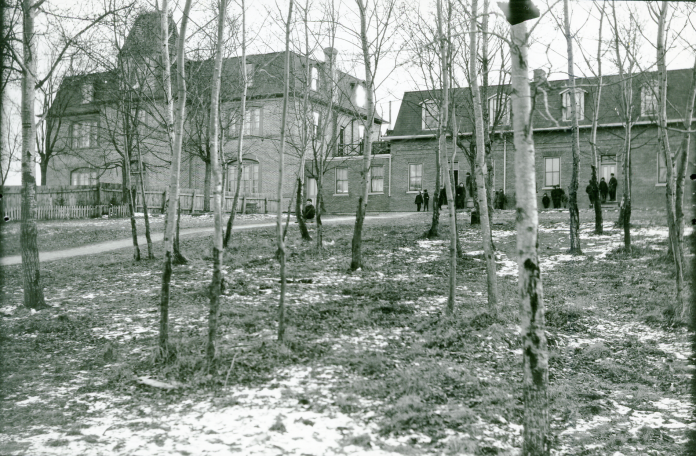
This is the twelfth in a series of columns about the 70 British Home Children sent to St. Patrick’s Catholic Orphanage in Prince Albert between 1901 and 1907. While all orphanage records were destroyed in the terrible fire of 1947, every attempt has been made to trace the life stories of these dispossessed children through genealogy websites and newspaper databases
Arthur Wooddeson: Child of Divorce
“That on the 23rd February 1901 [William and Mary Jane Wooddeson] separated from one another by mutual consent on account of the intemperate habits of the said Mary Jane Wooddeson and [William] made her a regular weekly allowance. [Mary] went to live at 101 Courland Grove Clifton Street, Clapham in the County of London. [William] never cohabited with his said wife after the 23rd February 1901. That on the month of March 1902 between the 13 and 23 of that month the said Mary Jane Wooddeson was delivered of a child of which [William] was not the father but he does not know and has been unable to ascertain who was the father of the said child.” William asked that the marriage be dissolved and that he be granted custody of their five children Harry, Herbert, Ethel, Rose, and Sidney. – Affidavit of William Wooddeson, divorce decree, Ancestry
The divorce of William Robert Wooddeson (1862-1914) and Mary Jane (Hutchins) Wooddeson was finalized in May 1903 on the grounds that she had had a child by another man. That child is the subject of today’s column, Arthur Victor Wooddeson, born in 1902.
Divorce in England before 1914 was rare. It was considered scandalous and was confined primarily to the upper classes who could afford the expense. A “pauper cause” divorce was paid for out of a fund set aside, often by churches, for very poor people whose property was valued at less than £25. It was difficult to obtain, as a petitioner would have to find a lawyer prepared to give their services for free (although out-of-pocket expenses were still payable). [Source: Penelope Russell, “Re-tying the Knot? Remarriage and Divorce by Consent in mid-Victorian England,” American Journal of Legal History, Volume 59, Issue 2, June 2019.]
William Wooddeson would have had some financial resources even though his divorce case was “pauper cause.” He worked as a milk carrier in London, delivering fresh milk door to door from a churn or barrel. Milkmen delivered at least twice a day and recorded every purchased item into a book in a leather pouch, collecting payment from their customers every week.
Mary Jane Wooddeson and her illegitimate son Arthur Victor were on their own after the divorce. She worked as a charwoman so she would have had to send her son to the Poor Law authorities, whether a children’s home or workhouse. From there, the Catholic Emigration Society decided Arthur should be shipped off to Canada.
On 12 July 1907, 5-year-old Arthur boarded the Empress of Britain after a stay at Elham Park House (likely part of the Elham workhouse complex) en route to Canada. By 1911, according to the British census, his 45-year-old mother Mary Jane was a patient in the Wandsworth Union Workhouse Infirmary, Battersea, London.
Arthur spent his school years at St. Patrick’s Catholic Orphanage in Prince Albert, Saskatchewan. In the 1920s, he moved to Guelph, Ontario where he worked as an attendant at the Homewood Sanitarium, a private institution for the treatment of mental illness and substance abuse. There he met his future wife, Rhoda Mae McKinnon, who worked as a nurse at Homewood.
Working conditions for the staff at what became known as the Homewood Retreat were not good. In her detailed study of the private asylum, Cheryl Lynn Krasnick Warsh writes in her book, Moments of Unreason, that while the first two medical superintendents, Stephen Lett ad Alfred Hobbs, made significant advances in both diagnostics and therapeutics, their contributions to psychiatry were “continually compromised by patients’ intrusive families, by independently minded and unskilled employees, and by the recalcitrant patients themselves.”
“Whatever the therapeutics favoured by Lett and Hobbs, sanctioned by the board, or approved of by patients and their families, it was the poorly paid, overworked nurses and attendants who carried out the physicians’ directives with … scant regard for the rationale behind the treatments or the motivations of the families. While the patients of the Homewood Retreat were drawn primarily from the same class as the directors and physicians, the nurses and attendants were drawn almost exclusively from a social class – and often from ethnic and religious groups — widely different from those of the others in the institution.”
It cannot have been easy for Arthur and Rhoda, especially after she became pregnant. They got married on 18 October 1929 in Guelph and promptly moved to Niagara Falls, New York where he secured a job as a compressor operator. Their only son, Harold Victor (Woody) Wooddeson 1930-2006) was born just prior to the recording of the 1930 US census in Niagara Falls on 4 April, 1930.
That’s all I’ve been able to find out about the life story of Arthur Victor Wooddeson, British Home Child. I do not know when he or Rhoda died, nor where they were buried. At some point they may have returned to Guelph, Ontario as that is where their son Harold was interred in 2006.

